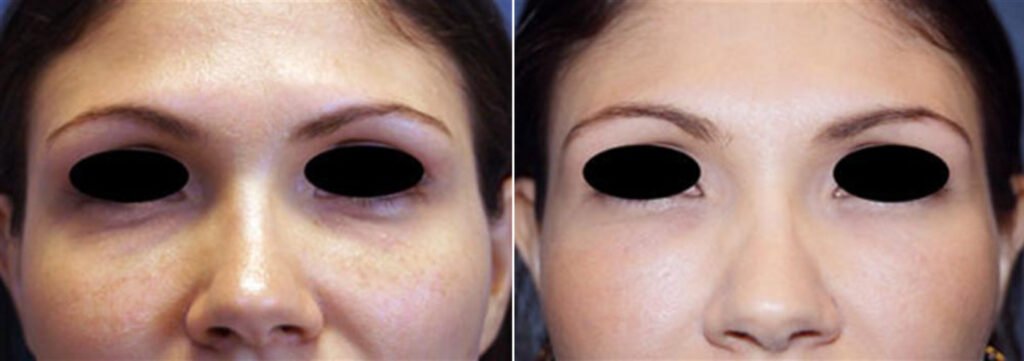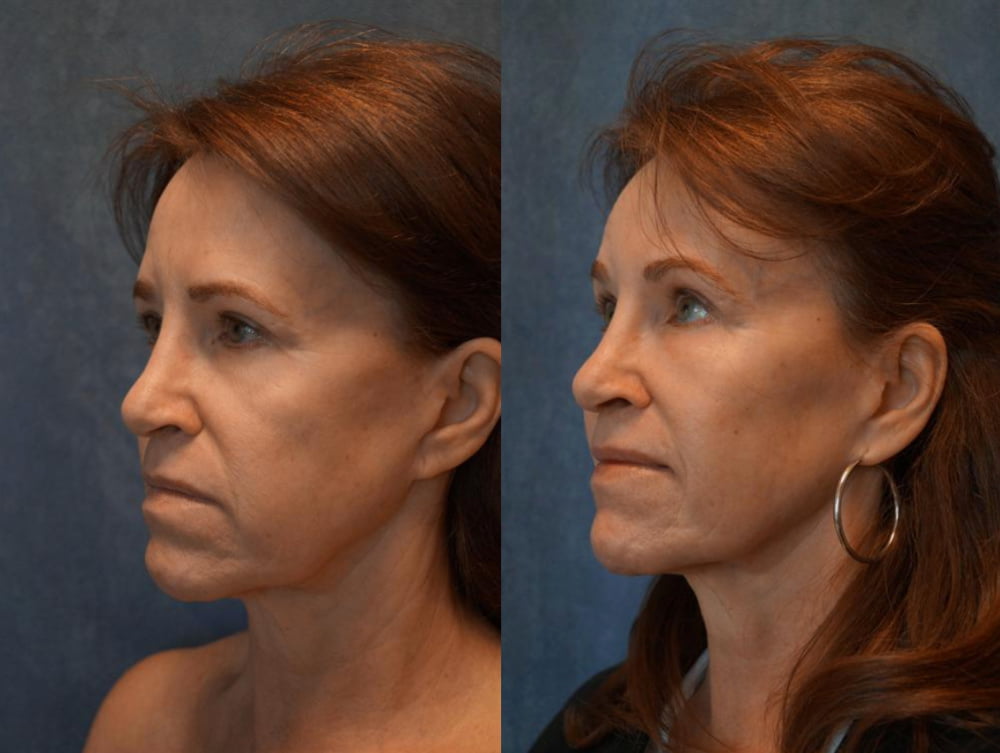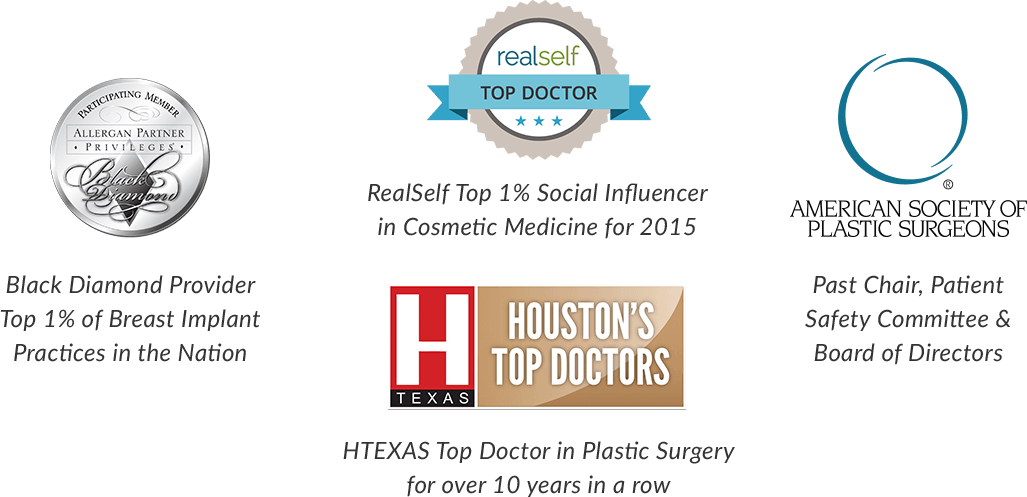Northwest Houston
Cypress Office
9899 Towne Lake Parkway, Suite 100
Cypress, Texas 77433
Call or text (713) 799-2278
Galleria/Uptown
Houston Office
1700 Post Oak BLVD, Suite 1-280
Houston, Texas 77056
Call or text (713) 799-2278
Facial Fat Transfer (Facial Fat Grafting)
As we age, facial fat diminishes, which can cause wrinkles, creases and sunken cheeks and eyes. By performing facial fat transfer using your own natural fat, renowned Houston plastic surgeon Dr. Bob Basu can restore fat to the areas of the face that have begun to deteriorate, returning volume and fullness for a more youthful appearance. Fat injections can also be used to fill areas of the skin that have become depressed, such as scars, acne scars and birthmarks. The fat transfer procedure is a minimally invasive method for creating subtle changes to the skin, effectively rejuvenating the face to combat the effects of aging.
Dr. Bob Basu is a board-certified plastic surgeon whose experience, combined with his sensitive approach to each person’s needs, makes him one of the top plastic surgeons in the area, helping men and women throughout Texas look and feel confident and refreshed.
Contact us online or call or text our office today at (713) 799-2278 to schedule a consultation at Basu Aesthetics + Plastic Surgery, conveniently located in Houston and Cypress.
Bob Basu, MD, MBA, MPH, FACS
- Princeton-Educated, Nationally Recognized, Board-Certified Plastic Surgeon
- Over 16,000 Cosmetic Procedures Performed
- Top Doc in “Best Plastic Surgeon” category for over a decade

How does fat grafting work?
During a fat transfer procedure, fat cells are harvested, purified, and then carefully re-injected into the target areas on the face using specialized techniques.
Benefits
Fat grafting can be beneficial for men and women looking to restore the youthful, energized appearance of their skin. Another benefit of the procedure is that it can simultaneously contour other areas of the body from which the fat is taken. The harvested fat can then be injected into the face to improve various skin and aging concerns, including:
- Lines and wrinkles
- Loss of fullness in the cheeks
- Hallow or sunken eye areas
- Uneven texture caused by acne scars, birthmarks or the aging process
- Thinning or lost volume in the lips
- Desire for improved shape or size of the breasts or buttocks (learn more about body fat transfer)
Some people prefer facial fat injections over dermal fillers (such as Juvederm, Restylane, or Sculptra) because fat grafting utilizes your own excess fat—thus eliminating the need for artificial or synthetic fillers.

Candidates
Individuals experiencing volume loss in their face due to aging, weight loss, or other factors may benefit from facial fat grafting. Please note that to be considered as a candidate for any surgical procedure, including fat transfer, you must be in good health, be a non-smoker, and have a BMI of 40 or less.
How much does facial fat grafting cost in Houston?
The cost of Houston facial fat grafting can vary depending on the extent of the procedure needed to acheive your unique needs and goals. At Basu Aesthetics + Plastic Surgery, we offer frequent special promotions for a variety of surgical and non-surgical plastic surgery procedures and treatments, as well as a variety of plastic surgery financing options to make your procedure as affordable as possible.
Your Fat Transfer Procedure
Consultation
During a consultation, Dr. Basu will evaluate your medical history, discuss your aesthetic goals, and assess your facial anatomy and skin quality. He will also explain the fat transfer procedure process in detail, including any potential risks and expected outcomes, and you’ll have the opportunity to ask questions. This initial meeting helps establish realistic expectations and determines whether you’re a suitable candidate for the procedure. We will also provide you with a pricing estimate for the total cost of your procedure at this time.
Preparing for Your Procedure
To prepare for fat grafting surgery, it is important that you strictly adhere to any specific pre-operative instructions provided by your surgeon. Generally, you should stop smoking at least six weeks before surgery to promote better healing. Avoid taking aspirin, anti-inflammatory drugs, and herbal supplements, as they can increase bleeding post-procedure. It is also beneficial to maintain a healthy diet and stay hydrated. In the days before the procedure, arrange for someone to drive you home post-surgery and assist you during the initial recovery period. Do not eat or drink anything if instructed to fast before the procedure, which is often required if you’ll be under general anesthesia. Following your surgeon’s specific guidelines will help ensure a smooth procedure and a successful recovery.
Fat Transfer: Surgical Technique
During a facial fat grafting procedure, fat is harvested from a donor site—commonly the abdomen, thighs, or flanks—through liposuction. The extracted fat is then purified and processed to isolate the fat cells. Using fine needles or cannulas, the purified fat is then carefully injected into the target areas of the face to enhance volume and contours. The procedure duration will vary depending on the amount of fat being transferred and the areas being treated, but typically takes a couple of hours.
Fat transfer procedures involve harvesting fat from another body area, then processing and injecting the fat into areas of the face or lips that require volume restoration.
Combining Facial Fat Grafting with other Procedures
Fat transfer is often paired with other surgical or non-surgical facial procedures to achieve more complete rejuvenation.
Surgical
- Facelift (Rhytidectomy): A facelift is designed to tighten and lift sagging skin, improving the overall contour and appearance of the face and neck. Combining this with facial fat transfer can add volume to hollow or sunken areas, providing a more comprehensive and youthful result.
- Blepharoplasty (Eyelid Surgery): Eyelid surgery corrects drooping upper lids and puffy bags below the eyes. When combined with fat injections, this procedure helps in restoring volume around the eyes, creating a more alert and refreshed appearance.
- Rhinoplasty (Nose Surgery): While rhinoplasty primarily focuses on reshaping the nose, fat injections can be used to smooth out irregularities or asymmetries, offering improved balance and proportion to the face.
- Brow Lift: A brow lift elevates the eyebrows and reduces creases on the forehead. Adding fat injections can help smooth out deep furrows and restore a softer, more youthful look to the upper face.
- Neck Lift: The neck lift procedure tightens loose or sagging skin in the neck area. When paired with facial fat injections, it can provide more harmonious and balanced rejuvenation from the chin down to the collarbone.
- Chin or Cheek Augmentation: Implants or other augmentation procedures for the chin and cheeks provide additional definition to these areas. Facial fat injections can further refine and balance these enhancements for a natural-looking result.

Non-Surgical
There are also a number of injectable treatment options that you may want to consider to complement your facial fat grafting procedure, including:
- BOTOX®: BOTOX® injections can target the root cause of lines and wrinkles, resulting in smoother, younger-looking skin.
- JUVÉDERM®: JUVÉDERM® works by injecting hyaluronic acid, a substance that is already naturally occurring in the body, into the skin to reduce lines and wrinkles by mimicking the effects of collagen.
- Lip enhancement: Fat injections may be used for lip enhancement, either alone or in combination with JUVÉDERM®.
- Chemical Peels or Facials: These skin rejuvenation techniques address surface imperfections, wrinkles, and sun damage. Facial fat injections complement these by filling in lost volume, enhancing the smoothness and plumpness of the skin.
Dr. Basu will work with you during your consultation to help you decide which facial restoration procedure or combination of procedures might best help you achieve the look you want.
Recovery & Downtime
Because everyone’s body heals differently, your recovery following fat transfer can vary. Typically, most people notice the added volume and fullness to their face within 1 to 2 weeks following the procedure, as some swelling and bruising may occur. Because some liposuction is also a necessary part of the fat removal process, it may be recommended that you limit your activity level for a few weeks post-op. Dr. Basu will provide you with thorough instructions to guide you through the recovery process to ensure maximum results.
Results
Although initial swelling and bruising may obscure the results, noticeable improvements are typically seen shortly after the procedure, with final outcomes evident in a few weeks to months. The longevity of results can vary from months to years, and in most cases, are quite long-lasting. To ensure and maintain optimal results, it is beneficial to follow all post-operative care instructions provided by your surgeon, maintain a stable weight, and adopt a healthy lifestyle. Regular follow-ups with your surgeon and possibly touch-up treatments can also help sustain your desired outcome.

Frequently Asked Questions
Do facial fat injections hurt?
Facial fat injections may cause mild to moderate discomfort. Pain levels can vary from person to person, but any pain is typically minimized with the use of local anesthesia, sedation, or pain medication as deemed appropriate by your provider. Patients may also experience soreness in both the donor and injection sites for a few days following the procedure.
What changes will I see in my face after fat transfer?
After a facial fat transfer procedure, you will likely notice restored volume, improved contouring, and a more youthful appearance in the treated areas of your face. The procedure helps in smoothing out wrinkles, filling in hollow or sunken areas, and enhancing the overall balance and proportions of your facial features. The results are typically quite natural-looking, as the filler is your own body fat.
How long will the facial fat last?
The longevity of results from a facial fat transfer can vary widely from person to person, with outcomes lasting anywhere from several months to several years. Factors influencing the duration of results include your age, lifestyle, the area(s) treated, and the technique your plastic surgeon used during the procedure.
Will weight loss affect my facial fat?
Weight loss can potentially affect fat transfer results since the fat cells transferred to your face can shrink, thus leading to a reduction in volume. The degree to which this can occur will depend on the amount of weight lost and individual variations in how and where your body loses fat. To maintain optimal results, it is advisable to keep a stable weight following the procedure.
How does facial fat injection compare to fillers or facelifts?
Facial fat grafting can provide a more natural and longer-lasting outcome compared to dermal fillers, as they utilize your own body fat. However, they do not provide as dramatic a lift or tightening effect as surgical facelifts. Facelifts do offer significant and immediate results in reducing sagging and improving the contours of the face, but involve more risks, costs, and downtime due to their invasive nature. During your personal consultation, Dr. Basu can discuss the pros and cons of each procedure, and help you determine which is best for you.
Where does the injected facial fat come from?
The fat is harvested from areas of the body that have excess fatty tissue. Common donor sites include the abdomen, thighs, flanks (love handles), and sometimes the buttocks. The chosen area usually has resilient fat deposits that are not significantly affected by weight fluctuations. One of the benefits of fat transfer is your ability to shrink one area, and grow another!
When can I go back to work after fat grafting?
The time it will take before you can get back to work will depend on the extent of the procedure, but generally, patients can expect to go back to work within a week to 10 days. For jobs that require physical activity or are more strenuous, a longer recovery period may be necessary to allow your body ample time to heal. Always follow the specific advice and guidelines provided by your plastic surgeon when preparing to return to normal life post-surgery.
Will insurance cover my plastic surgery procedure?
Insurance typically does not cover elective cosmetic procedures, including plastic surgery and fat transfer procedures, as they are often considered not medically necessary. However, if the procedure is being performed for reconstructive or medical reasons, such as following an injury, accident, or surgery, insurance might partially or fully cover the costs. We recommend you consult with your insurance provider to understand your coverage and financial responsibility.
Schedule Your ConsultationTo take the first step toward achieving a younger, refreshed look through fat injections, contact us online or call or text our Houston office today at (713) 799-2278. Award-winning plastic surgeon Dr. Bob Basu, facial plastic surgeon Dr. Taylor DeBusk, and our incredible aesthetics team are here to help you safely and effectively reach your desired goals!

